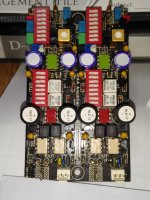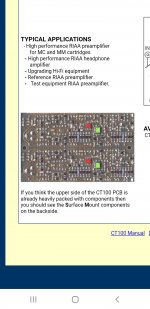Hi,
I own a DACT CT-100 phono stage for more than 20 years. However, I rarely play LPs in the recent years, but keeping the practice of warming it up by just switching on once a week. To my surprise, channel 1 was dead (dead silence) when I tried to playback some LPs last week. I'm not sure whether it could have gone bad unnoticed quite some time ago.
Upon checking the board by comparing with the good channel 2, a ZR431 and a zener diode went bad and both were replaced. Although the supply was restored, but still no sound passing through channel 1. Hence, I am worried about one or more op amps could be faulty. So, I need help to identify what the op amp models are, as all of them are disguised with paint coatings. Greatly appreciate any suggestion to what the possible op amp types/models are (painted white, red and green)? Thanks in advance.
Best regards,
Fong
I own a DACT CT-100 phono stage for more than 20 years. However, I rarely play LPs in the recent years, but keeping the practice of warming it up by just switching on once a week. To my surprise, channel 1 was dead (dead silence) when I tried to playback some LPs last week. I'm not sure whether it could have gone bad unnoticed quite some time ago.
Upon checking the board by comparing with the good channel 2, a ZR431 and a zener diode went bad and both were replaced. Although the supply was restored, but still no sound passing through channel 1. Hence, I am worried about one or more op amps could be faulty. So, I need help to identify what the op amp models are, as all of them are disguised with paint coatings. Greatly appreciate any suggestion to what the possible op amp types/models are (painted white, red and green)? Thanks in advance.
Best regards,
Fong
Attachments
There's no way to know unless there is a service manual, which is not likely if they paint over the markings.
Although, you could ask DACT what the op amps are (if the op amp models are even still made).
Although, you could ask DACT what the op amps are (if the op amp models are even still made).
Last edited:
You have two identical channels there by the looks of it.
First thing I would do would be to check the voltages on the opamps... assuming they are all opamps. Pin 4 would be expected to be the negative rail and either pin 7 or 8 for positive depending on whether single or dual opamp. In any case, just compare.
For a single opamp pins 2, 3 and 6 might be expected to be at zero volts while for a dual opamp pins 1, 2, 3 and 5, 6 and 7 might be expected to be zero.
First thing I would do would be to check the voltages on the opamps... assuming they are all opamps. Pin 4 would be expected to be the negative rail and either pin 7 or 8 for positive depending on whether single or dual opamp. In any case, just compare.
For a single opamp pins 2, 3 and 6 might be expected to be at zero volts while for a dual opamp pins 1, 2, 3 and 5, 6 and 7 might be expected to be zero.
FWIW, I had a CT101 go faulty with a bad opamp (white epoxy covered) DACT would not divulge what type it was but confirmed (most) single op amp's would work (but would not sound as good). From the fact it had an SR of 500V/us is was likely a current feedback device. I replaced both channels with OPA 627's.
Although it should have been obvious that those multiple switches needed at least some passive components to switch , i didn't figure it out either before I saw that picture...
I should add if I had to go thru the exercise again today I'd replace with OPA1611 if bipolar input and OPA1655 if fet, which I suspect the green epoxy ones are. Far better spec and cheaper than whats probably in there. I can also understand wanting to keep it original. Its a very nice phono stage.
Hi all,
Thanks for all the suggestions. By following Mooly's advice, the pin 4 of the "green" op amp in the faulty channel was found to be lacking the expected negative rail. It's quite difficult to trace a double-sided densely populated PCB in this case, with the top layer painted black. Has anyone studied this circuit board before?
Thanks
Thanks for all the suggestions. By following Mooly's advice, the pin 4 of the "green" op amp in the faulty channel was found to be lacking the expected negative rail. It's quite difficult to trace a double-sided densely populated PCB in this case, with the top layer painted black. Has anyone studied this circuit board before?
Thanks
Just a suggestion. When you have the faulty circuit live. Look back to what op-amps where available all those years ago. Could be the TL072. Find a modern replacement & replace the pair.
Cheers
Cheers
Hi,
Sorry, I'd made a mistake during the measurement without a magnifying glass. Pin 4 of the said op amp is still good when I tried once more. Another strange finding - high voltages are measured at the audio output "+" and "-" pins (12v, 11.67v respectively) of the faulty channel, whereas the good channel reads zero. Is this dc offset?
Since this is a product from more than 2 decades ago, various ICs eg. ZR431 , ZRA124 are hard to find in their original form because of product end-of-life . I used paint stripper on one of the painted op amp and it turned out to be a bare surface where all markings were sanded off.
Thanks and best regards,
Sorry, I'd made a mistake during the measurement without a magnifying glass. Pin 4 of the said op amp is still good when I tried once more. Another strange finding - high voltages are measured at the audio output "+" and "-" pins (12v, 11.67v respectively) of the faulty channel, whereas the good channel reads zero. Is this dc offset?
Since this is a product from more than 2 decades ago, various ICs eg. ZR431 , ZRA124 are hard to find in their original form because of product end-of-life . I used paint stripper on one of the painted op amp and it turned out to be a bare surface where all markings were sanded off.
Thanks and best regards,
Another strange finding - high voltages are measured at the audio output "+" and "-" pins (12v, 11.67v respectively) of the faulty channel, whereas the good channel reads zero. Is this dc offset?
It sounds a bit that way.
It is really difficult at a distance to diagnose this... we need as much info as possible really. No promises but knowing all the voltages on all the pins might give a clue.
If you could set them out like
IC1A pin1 =
IC1A pin2 =
and so on then we might spot something.
Hi Mooly,
Please see the op amp data collection in attached pdf for analysis. Please take note that the smaller SMD op amps on the back have no visible pin 1 identification. Furthermore, there are numerous TO-92 ICs (NPN/PNP) to worry about.
Thanks and best regards,
Please see the op amp data collection in attached pdf for analysis. Please take note that the smaller SMD op amps on the back have no visible pin 1 identification. Furthermore, there are numerous TO-92 ICs (NPN/PNP) to worry about.
Thanks and best regards,
Attachments
SMD op amps have a beveled top edge on the pin 1 side, in some cases.
See different data sheets....
I would expect TL072, 5532 or OPA series...or rarely AD797.
See the rail voltages, most will max. out at 22V, so 18-20V supplies are expected.
And it could be a stupid fault, like a dry joint, ICs rarely fail just sitting around.
I would check the supply first. Then electrolytics, finally other caps.
See different data sheets....
I would expect TL072, 5532 or OPA series...or rarely AD797.
See the rail voltages, most will max. out at 22V, so 18-20V supplies are expected.
And it could be a stupid fault, like a dry joint, ICs rarely fail just sitting around.
I would check the supply first. Then electrolytics, finally other caps.
- Home
- Source & Line
- Analogue Source
- Need help to identify op amps in DACT CT-100 phono stage

